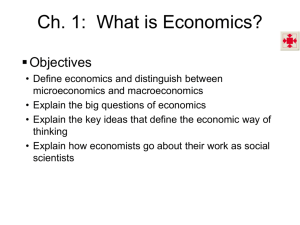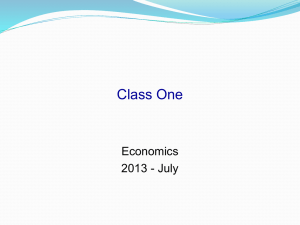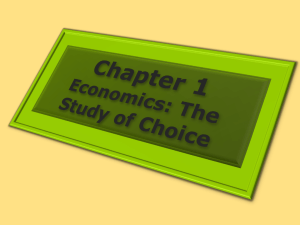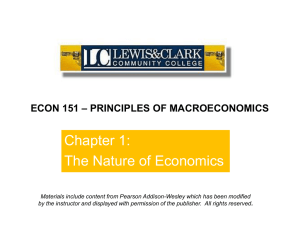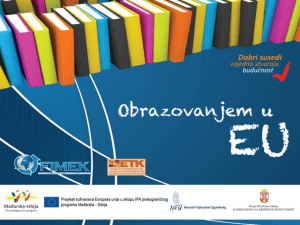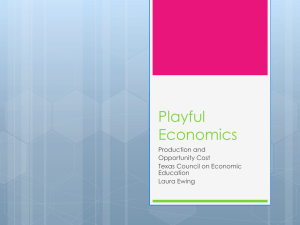Two Big Economic Questions
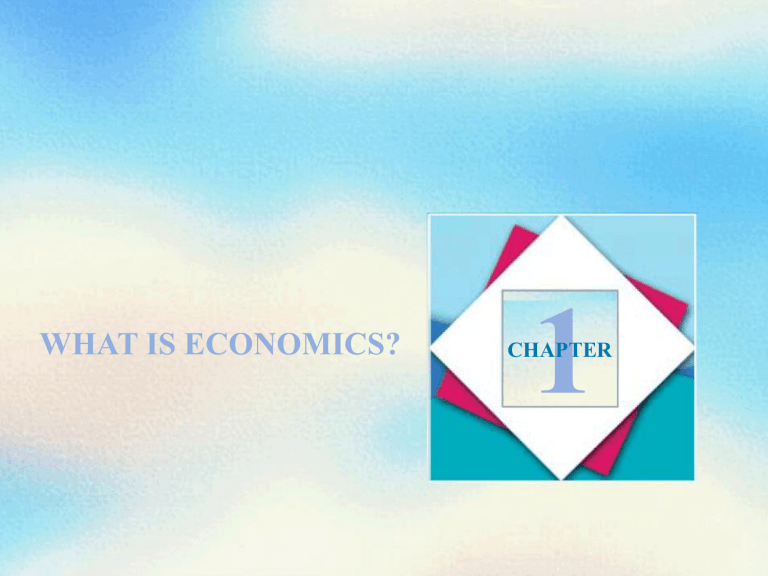
WHAT IS ECONOMICS?
Definition of Economics
All economic questions arise because we want more than we can get.
Our inability to satisfy all our wants is called scarcity .
Because we face scarcity, we must make choices .
The choices we make depend on the incentives we face.
An incentive is a reward that encourages or a penalty that discourages an action.
Definition of Economics
Economics is the social science that studies the choices that individuals, businesses, governments, and societies make as they cope with scarcity and the incentives that influence and reconcile those choices.
Definition of Economics
Microeconomics
Microeconomics is the study of choices made by individuals and businesses, and the influence of government on those choices.
Macroeconomics
Macroeconomics is the study of the effects on the national and global economy of the choices that individuals, businesses, and governments make.
Two Big Economic Questions
Two big questions summarize the scope of economics:
How do choices end up determining what , how , and for whom goods and services get produced?
When do choices made in the pursuit of self-interest also promote the social interest ?
Two Big Economic Questions
What, How, and For Whom?
Goods and services are the objects that people value and produce to satisfy wants.
What?
What we produce changes over time.
Sixty years ago, almost 25 percent of Americans worked on farms: Today that number is 3 percent.
Today, almost 80 percent of Americans provide services.
Two Big Economic Questions
How?
Goods and services are produced by using productive resources that economists call factors of production .
Factors of production are grouped into four categories:
Land
Labor
Capital
Entrepreneurship
Two Big Economic Questions
The “gifts of nature” that we use to produce goods and services are land .
The work time and effort that people devote to producing goods and services is labor .
The quality of labor depends on human capital , which is the knowledge and skill that people obtain from education, on-the-job training, and work experience.
Two Big Economic Questions
The tools, instruments, machines, buildings, and other constructions that are used to produce goods and services are capital .
The human resource that organizes land, labor, and capital is entrepreneurship .
Two Big Economic Questions
For Whom?
Who gets the goods and services depends on the incomes that people earn.
Land earns rent .
Labor earns wages .
Capital earns interest .
Entrepreneurship earns profit .
Two Big Economic Questions
You make choices that are in your self-interest —choices that you think are best for you.
Choices that are best for society as a whole are said to be in the social interest .
Is it possible that when each one of us makes choices that are in our self-interest, it also turns out that these choices are also in the social interest?
The Economic Way of Thinking
Choices and Tradeoffs
The economic way of thinking places scarcity and its implication, choice , at center stage.
You can think about every choice as a tradeoff — an exchange —giving up one thing to get something else.
The classic tradeoff is “guns versus butter.”
“Guns” and “butter” stand for any two objects of value.
The Economic Way of Thinking
If we save more, we can buy more capital and increase our production.
If we take less leisure time, we can educate and train ourselves to become more productive.
If businesses produce less and devote resources to research and developing new technologies, they can produce more in the future.
The choices we make in the face of these tradeoffs determine the pace at which our economic condition improves.
The Economic Way of Thinking
Opportunity Cost
Thinking about a choice as a tradeoff emphasizes cost as an opportunity forgone.
The highest-valued alternative that we give up to get something is the opportunity cost of the activity chosen.
Ceteris paribus is a Latin phrase that means “other things being equal.”
The Economic Way of Thinking
Choosing at the Margin
People make choices at the margin , which means that they evaluate the consequences of making incremental changes in the use of their resources.
The benefit from pursuing an incremental increase in an activity is its marginal benefit .
The opportunity cost of pursuing an incremental increase in an activity is its marginal cost .
Economics: A Social Science
Social science
Economics is a social science.
Economists distinguish between two types of statement:
What is —positive statements
What ought to be —normative statements
A positive statement can be tested by checking it against facts
A normative statement cannot be tested.
Economics: A Social Science
Social science
The task of economic science is to discover positive statements that are consistent with what we observe in the world and that enable us to understand how the economic world works.
This task is large and breaks into three steps:
Observation and measurement
Model building
Testing models
Economics: A Social Science
Observation and Measurement
Economists observe and measure economic activity, keeping track of such things as:
Quantities of resources
Wages and work hours
Prices and quantities of goods and services produced
Taxes and government spending
Quantities of goods and services bought from and sold to other countries.
Economics: A Social Science
Model Building
An economic model is a description of some aspect of the economic world that includes only those features of the world that are needed for the purpose at hand.
Economics: A Social Science
Testing Models
An economic theory is a generalization that summarizes what we think we understand about the economic choices that people make and the performance of industries and entire economies.
A theory is a bridge between a model and reality. It is a proposition about which model works.
